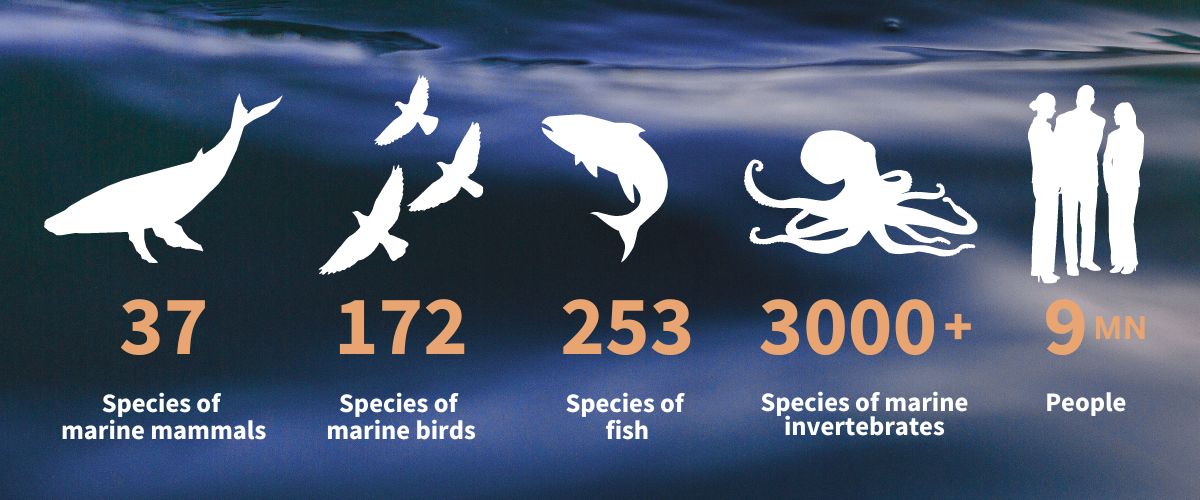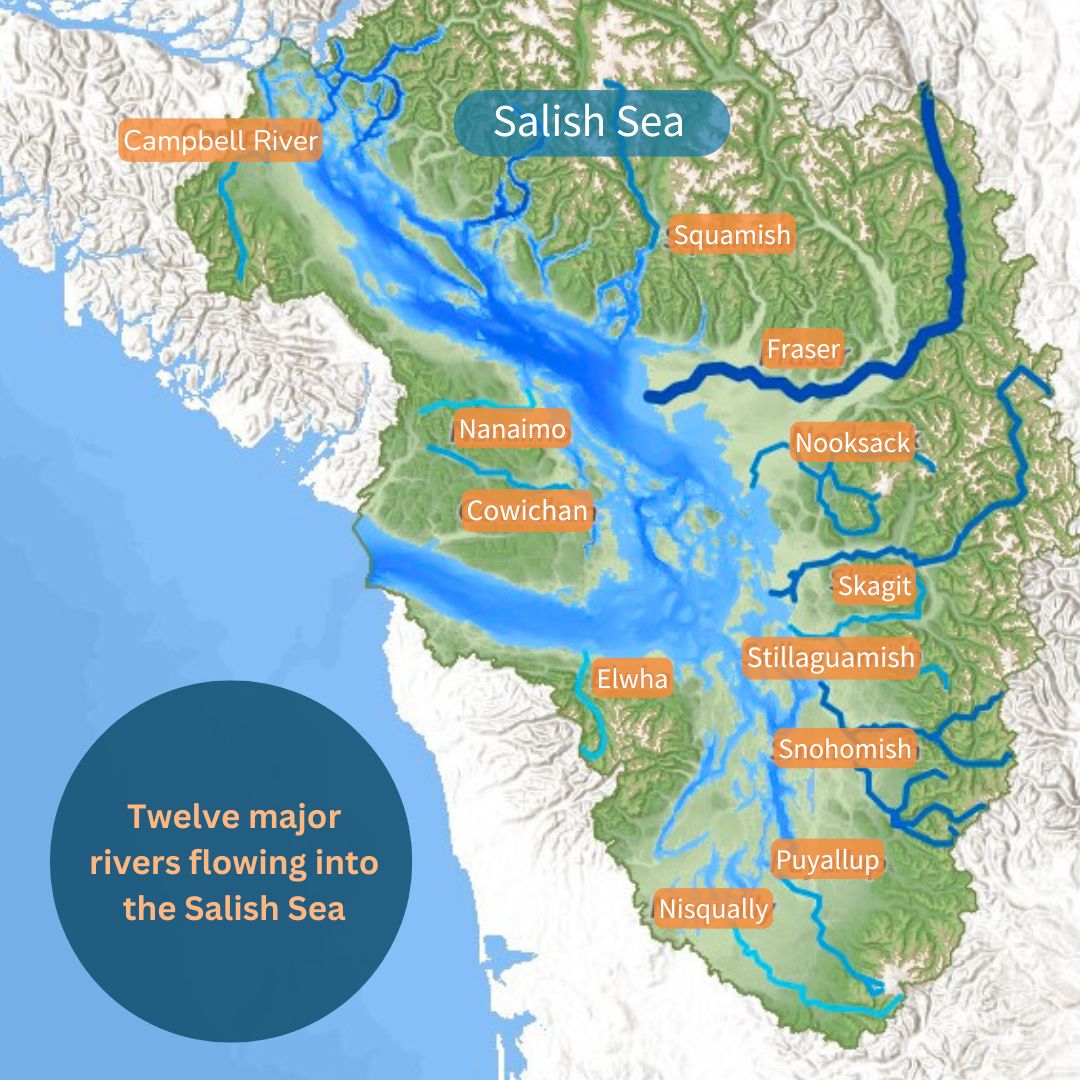
The morning sun has risen. The sky is painted in orange hues. Birds dive down swiftly for their morning meal. The splashes indicate the ceremonious return of salmon to their birthplace. The blows in the distance mean the Orcas are wading through the waters, tightly bound within their matrilines. Below the waters, the eelgrass sway in rhythm with the currents. The waves touch your feet, taking away remnants of any tiredness in your body as it flows back into the sea. What a refreshing start to the day, and what great fortune it is to call this the ‘mundane’!
A lot of us reading this are lucky to call the Salish Sea our home, named in honor of the first inhabitants of the region, the Coast Salish peoples. This is one of the most biodiverse regions on the planet and its uniqueness is significantly enhanced when we delve deeper into its geological context.
An estuarine system
Shaped by tectonic activity and glacial movements, The Salish Sea is identified as an estuarine system with twelve major rivers depositing freshwater reserves into sea. Similar to the vital process of veins transporting deoxygenated blood to the heart, for the heart to then filter and continue fundamental biological processes, rivers help channeling freshwater into the sea. This interplay of freshwater and saltwater helps a rich diversity of marine species and human communities to thrive. An astounding 3,400 species and 9 million people consider the Salish Sea their home. Of these 3,400 species, 37 are marine mammals, 172 are marine birds, 253 are fish – including all seven species of Pacific Salmon, and over 3000 are marine invertebrates.

As these rivers flow into the sea, they represent vitality, bringing along with them the gift of life. The influx of the nutrients brought in by the freshwater stimulates growth of tiny phytoplankton plants which form the base of the entire food web. Many species of migratory birds and salmon use these oxygen-rich brackish estuarine waters to complete various stages of their life cycles. Salmon spawn in freshwater rivers and spend their early life stages in estuaries before transitioning into saltwater. At the end of their life cycle, they make their way back to the freshwater river to spawn. This momentous journey is supported by the rich habitat conditions provided by the estuarine characteristics of the Salish Sea.
With every ripple and reverberation from this water, the delicate balance of the marine food web is restored with the transfer of minerals and nutrients, oxygen and organic matter that helps in nutrient cycling. This region is also culturally significant for Indigenous peoples as it has provided food, medicine and a mode for transfer since time immemorial.

Map derived from the Salish Sea Atlas: Freshwater in the Salish Sea Bioregion
A different tomorrow
The awe-inspiring beauty and the miracles of nature are ours to witness today, but the somber reality is, it might be a different tomorrow. We are living in a time where these natural resources are viewed as economic vehicles and are often extracted for immediate profit. Economic prosperity is a noble goal for a nation’s progress, but when it is planned at the expense of the environment, it is a hollow victory tainted by the cost of our planet’s well-being. The species residing in the Salish Sea such as the endangered Southern Resident Killer Whales (74 remaining individuals), the Giant Pacific Octopus (the largest octopus species in the world), Humpback Whales, the Lion’s Mane jellyfish (the largest jellyfish in the world) and the numerous others are irreplaceable, and once lost we will lose an integral part of our natural and cultural heritage.
Alarmingly, the number of marine species in the Salish Sea listed as endangered or threatened nearly doubled from 64 to 125 in the last fifteen years. Of the seven species of salmon, Chinook, Coho, and Steelhead have experienced up to tenfold decline in their marine lifecycle phase and their populations have fallen way below what they were forty years ago.
Massive and destructive projects like the TMX pipeline and the Roberts Bank Terminal threaten the health of the Salish Sea and exacerbate the threats to marine life by increasing vessel traffic by exponential amounts (700% by the TMX pipeline). This is accompanied by the increased risk of oil spills, vessel strikes, and underwater ocean noise, leaving species like the iconic salmon and Southern Residents fighting for their right to survive. The cumulative effects of numerous projects in the Salish Sea bioregion can overwhelm local ecosystems, lead to long-term degradation of the water quality and health of biodiversity.
This World Rivers’ Day, we take a moment to express our gratitude to the Salish Sea, recognizing its role in maintaining healthy marine ecosystems and providing immense support to the communities that depend on it. But we also remind ourselves of the battles we must engage in to protect the lifelines of the Earth. Let us give a chance for the future generations to experience the ‘mundane’!
Support our initiatives
- Sign up for GSA’s newsletter to be updated with all the work we do to protect the Salish Sea region.
- Follow us on Instagram & Facebook for regular updates on events and campaigns!
- Feel free to reach us at gsa@georgiastrait.org if you have any questions or drop us a comment in the box below.
- Find more ways to get involved here!
- Donate for a healthy Salish Sea.
